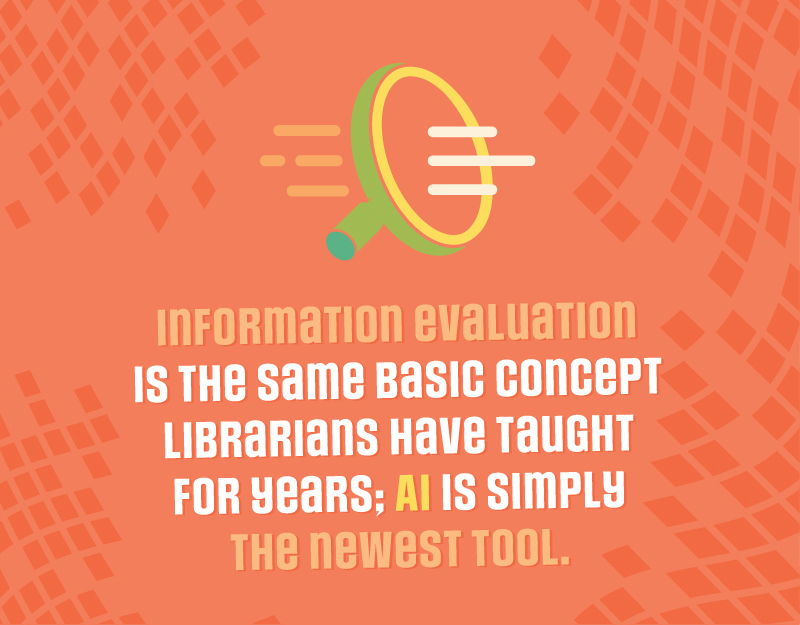Teaching Students AI Literacy: The Road Ahead
Is ChatGPT the new Wikipedia, riddled with inaccuracies, used by students seeking a shortcut? It could be. But it doesn’t have to be. That points to our next venture as librarians: AI literacy instruction.

Related reading: |
Artificial intelligence (AI) is a hot topic among librarians, who for the most part are more intrigued by AI than alarmed. We’ve been at the forefront of evaluating information from the beginning of the profession. When the internet rolled around, we had to teach website evaluation with the CRAAP test, the tree octopus lesson, and that tricky monster Wikipedia. CRAAP was replaced by lateral reading recently as our internet use and practices evolved and as information evaluation became part of classroom instruction. Now our evaluation instruction needs to evolve, too.
So is ChatGPT the new Wikipedia, riddled with inaccuracies, used by “lazy” or stressed students looking for a shortcut? The answer is the same as always when it comes to technology: It could be. But it doesn’t have to be. And that points to our next venture as librarians: teaching AI literacy.
In many ways, we can correlate teaching AI within our traditional information literacy instruction. Here is what a loose initial framework for interacting effectively with AI might look like from that perspective, including teaching input and response, vocabulary, and appropriate use.
Input: Instead of using search terms, with AI, a person asks a question and refines it. Teaching AI means teaching how to communicate with AI. Unlike a Google search, it’s an interaction, not a transaction. We have taught students how to search using Boolean operators, to lean toward .orgs and .edus. These are search skills, not communication skills. After years of telling students not to use natural language with databases, we now need to tell them to do the reverse with AI. Just as we encourage them not to stop at the first Google search results, they should not stop at the first AI response. Instead, they should respond to it, recognizing and identifying errors and providing more information and specificity for a better result and a better interaction. The goal is to expertly formulate queries and requests by communicating with AI by optimizing natural language processing. (See Glossary of Terms.)
Vocabulary: We need to teach basic vocabulary often associated with AI. Chances are you had not used the phrase “generative AI” prior to the emergence of ChatGPT. If students understand the vocabulary around how AI “learns,” they’re more likely to understand its strengths and weaknesses.
Appropriateness: Students need to understand when ChatGPT is a good place to go for information and when it is not the best resource for their needs. Information literacy instruction taught them when to use an almanac, a database, a newspaper, etc. Certainly in terms of currency, we need to stress that the knowledge base of ChatGPT ends in 2021, so it is not a source for up-to-the-minute information or current events. If a student wants a book recommendation, they might get good results to further explore on Amazon. If scientific or mathematical accuracy is required, they will need to verify bot results, possibly using lateral reading, or simply using a more reliable source. In a real-life scenario, asking ChatGPT to review the latest video games will yield a disappointing result, whereas magazines and websites like Wired and PC Gamer are better sources. Information evaluation is the same basic concept librarians have taught for years; AI is simply the newest tool.
Caveats and practical stumbling blocks: While we can compare teaching AI literacy to teaching database and information literacy, there are two main issues that differ, and both come down to access. First, do your students have access to AI, mainly ChatGPT, from school? At my school, it is blocked for students on school networks. Some schools, school districts, and even colleges and universities are banning access via school Wi-Fi—while others are beta-testing and trying out Khan Academy’s AI tutor, Khanmigo. The question is whether it undermines school policy to teach skills for a resource students cannot even access from school but will access nonetheless to some extent.
The second concern is cost. Schools offer students access to expensive proprietary databases they would not be able to afford on their own. While there is free access to ChatGPT, without a paid subscription, users are likely to get the message “ChatGPT is at capacity right now.” Equity of access is therefore a significant roadblock to teaching AI at school.
That should not stop librarians from thinking about a framework for teaching AI literacy. Embracing the uphill journey of teaching AI literacy recalls ongoing struggles and solutions to ensuring equal access to computers and the internet. Eventually, we will level the playing field and may soon witness AI literacy spreading like wildfire, then being normalized as an inherent part of education. In some ways, AI is the ultimate experiment in inquiry-based learning, where students increase their comprehension of subject matter and explore personal interests. And that sounds a lot like the ubiquitous phrase “creating lifelong learners.”
Lee De Groft is the director of library and information services at Trinity Preparatory School in Winter Park, FL.
RELATED
The job outlook in 2030: Librarians will be in demand
The job outlook in 2030: Librarians will be in demand
ALREADY A SUBSCRIBER? LOG IN
We are currently offering this content for free. Sign up now to activate your personal profile, where you can save articles for future viewing






Add Comment :-
Be the first reader to comment.
Comment Policy:
Comment should not be empty !!!